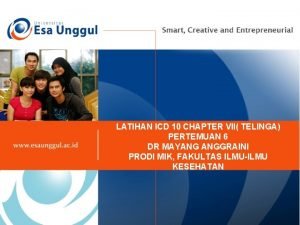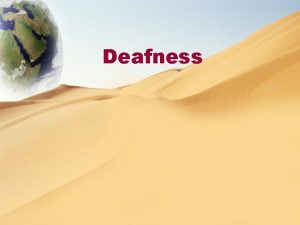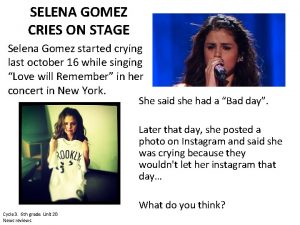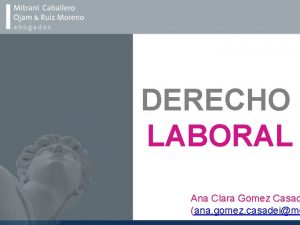DEAFNESS MONICA GOMEZ IDEA DEFINITIONS Deafness means a










- Slides: 10

DEAFNESS MONICA GOMEZ

IDEA DEFINITIONS • Deafness means a hearing impairment that is so severe that the child is impaired in processing linguistic information through hearing, with or without amplification, and that adversely affects a child’s educational performance. • Hearing impairment means an impairment in hearing, whether permanent or fluctuating, that adversely affects a child’s educational performance but that is not included under the definition of deafness.

DETERMINATION OF ELIGIBILITY • Inability to recognize most words spoken at a conversational level in a quiet room without the use of assistive devices • Significant receptive or expressive language delay • Impairment of speech articulation, voice, or fluency • Significant delay in development of reading skills because of language deficit • Inattention or serious behavior problems related to the hearing loss (Luckner & Friend, 2014, p. 369)

SOCIAL IMPLICATIONS Early Childhood/Adolescence/ Adulthood • In the preschool years, “they have fewer interactions as well as less exposure to social language (i. e. , pragmatics- such as appropriate turn taking) and emotional language (e. g. , vocabulary such as delightful or cruel)” (Luckner & Friend, 2014, p. 366). • Early intervention specialist help the baby interact socially. • Provide positive reinforcement/praise for positive specific behaviors Deaf children tend to have… • Fewer friends • Parents who have more restrictive rules for behavior • Parents who are unable to communicate expectations about social interactions Deaf Culture • Deafness is viewed as an identity, with its own history, traditions, and language. • Deafness is not seen as a disability needing to be fixed. • Against cochlear implants because it implies that deafness is needing to be cured. • Unlikely to form positive relationships with hearing peers unless intervention from professionals

EMOTIONAL IMPLICATIONS Early Childhood/Adolescence/ Adulthood • Social/Emotional development suffers due to lack of interaction with people using social skills. • The research that I found is the same as social Implications. • “Deaf children are less able to identify emotions on faces than are hearing children matched on chronological and mental age” (Ludlow, Heaton, Rosset, Hills, & Deruelle, 2010, p. 926). • May not understand why people act or react the way they do • Limited vocabulary of emotional language that helps them understand their feelings • “Barriers to communication and self-expression have likely resulted in the high levels of frustration and maladaptive coping behaviors that are characteristic of aggression” (Coll, 2009, p. 33). • Best adjusted adolescents are those who have deaf parents. • Promotion of Deaf culture

TURN & TALK If a student who is deaf was in your class, whether in special education or general education, how would you help him develop friendships with his hearing peers?

ACADEMIC IMPLICATIONS Early Childhood/Adolescence/ Adulthood • Parents may not read to them, negatively affecting literacy development. • Lack exposure to experiential backgrounds to build schema • Cochlear implants help develop spoken language and listening skills which helps close academic gaps. • Learning to read and learning to communicate at the same time. • Struggle with writing because it is dependent on speech or sign. • Achieve higher in math than reading and writing, but they still struggle. • Bilingual-bicultural approach • Many are not successful in postsecondary education because cognitive academic language proficiency (CALP) is lacking. • Not educated to the level of their capability • Educators need to realize their potential and provide them with resources.

MEDICAL IMPLICATIONS “Whenever deafness is identified, search for additional physical disabilities” (Schein & Miller, 2008, p. 408). Early Childhood/Adolescence/ Adulthood • q q • • • Cochlear implants at 12 months of age The sooner the better Best if no additional disabilities are present Attend program that promotes auditory oral/verbal development Has a family that promotes listening and communication skills Ophthalmic Disorders Kidney Dysfunctions Heart Conditions Usher syndrome- condition that affects both hearing and vision Syncope (fainting spells) is most common in teenage girls. Alport syndrome- kidney dysfunction

STOP & JOT Think about students who have a profound hearing loss. What might be the advantages or disadvantages of them receiving a cochlear implant?

References Coll, K. M. , Cutler, M. M. , Thobro, P. , Haas, R. , & Powell, S. (2009). An Exploratory Study of Psychosocial Risk Behaviors of Adolescents Who Are Deaf or Hard of Hearing: Comparisons and Recommendations. American Annals Of The Deaf, 154(1), 30 -35. doi: 10. 1353/aad. 0. 0074 Friend, M. , Luckner (2014). Students with deafness and hearing loss. In A. C. Davis (Ed. ), Special education contemporary perspectives for school professionals (pp. 350 -387). New Jersey: Pearson. Ludlow, A. C. , Heaton, P. , Rosset, D. , Hills, P, . & Deruelle, C. (2010). Emotion recognition in children with profound and severe deafness: Do they have a deficit in perceptual processing? . Journal Of Clinical & Experimental Neuropsychology, 32(9), 923 -928.
 Monica gomez terapia clark
Monica gomez terapia clark Congek telinga kanan icd 10
Congek telinga kanan icd 10 What is the difference between topic and theme
What is the difference between topic and theme What is the main/ central idea and how do i find it?
What is the main/ central idea and how do i find it? What is an irrelevant sentence
What is an irrelevant sentence Exegetical idea vs homiletical idea
Exegetical idea vs homiletical idea Main idea and supporting details
Main idea and supporting details Supporting ideas
Supporting ideas Maksud ayat topik
Maksud ayat topik Define paragraph unity
Define paragraph unity Showing off is the fool's idea of glory means
Showing off is the fool's idea of glory means



















